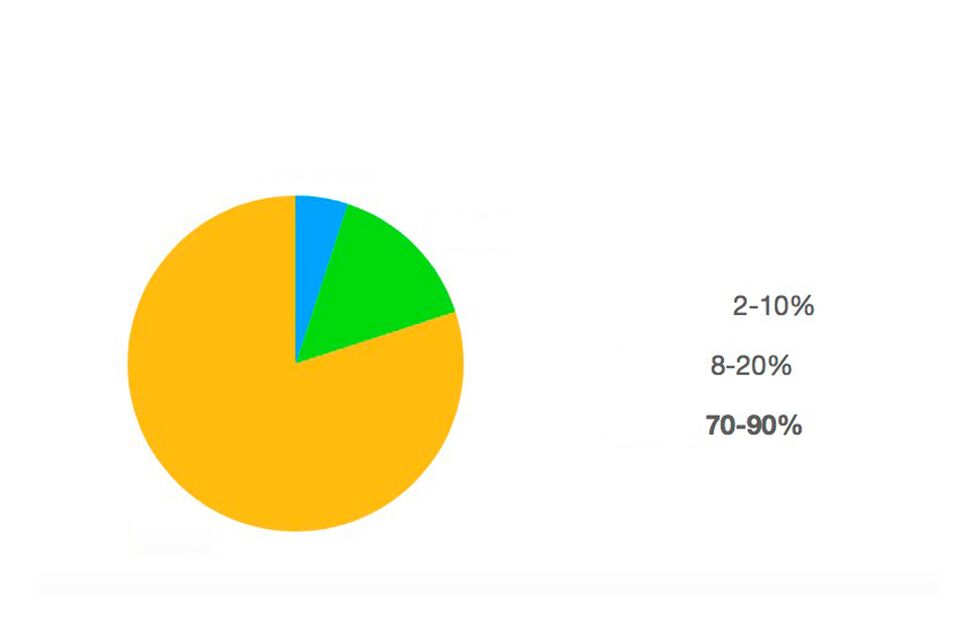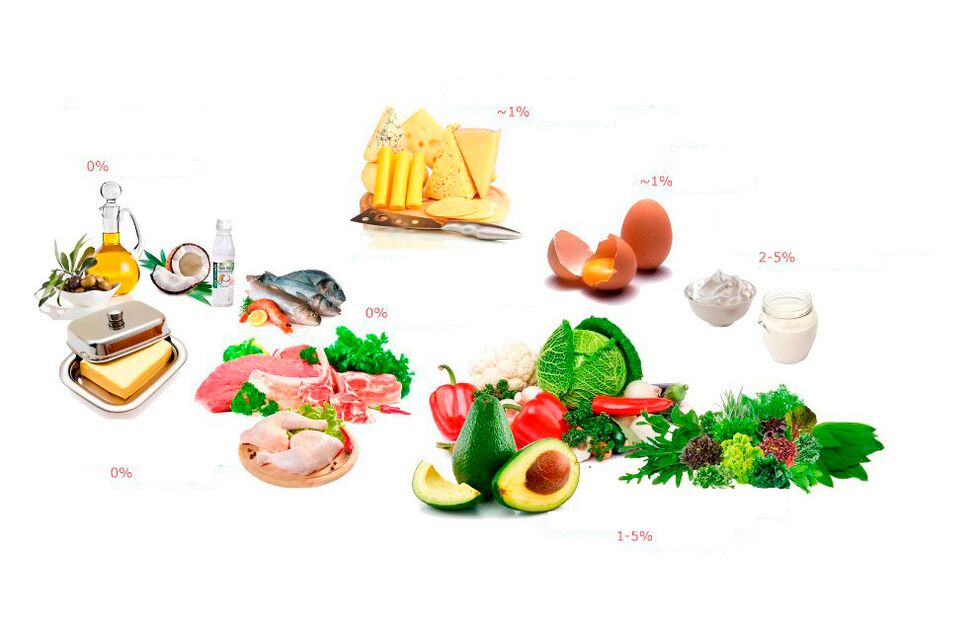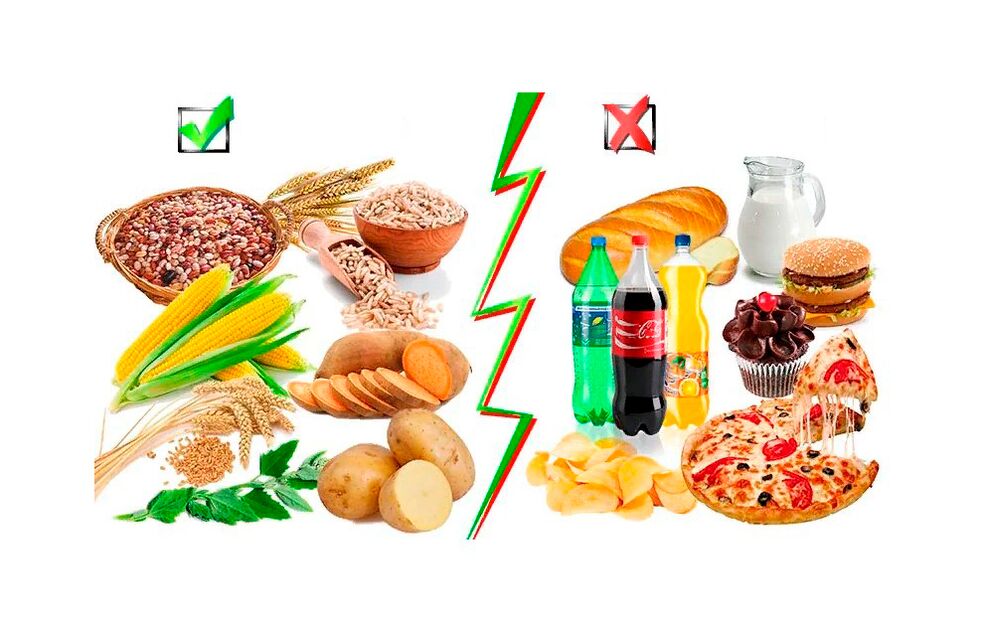A carbohydrate-free diet is an extreme version of a low-carbohydrate diet, where the diet focuses on protein, healthy fats, and fiber.
To provide energy for the body and brain, our body usually uses carbohydrates (glucose). Their reduction leads to a decrease in the production of insulin in the body, so as an alternative source, it begins to break down protein (muscle reserves) and stored fat. This leads to rapid weight loss.
Depending on age, weight, physical activity, and goals (weight loss, increased muscle mass, dry body), the body needs different amounts of protein, fat, and carbohydrates (BJU). According to experts, the average daily consumption is as follows:
- 45-65% carbohydrate
- 20-35% fat
- 10–35% protein
With a low-carbohydrate diet, fat becomes the main source of calories and carbohydrates are reduced to 2-10%.

The general principles of a carbohydrate-free diet are as follows:
- The consumption of carbohydrates has been reduced from 0 grams to 30 grams per day.
- Make sure to drink at least 8-12 glasses of water every day to get rid of toxins from the body.
- Since most of your diet consists of protein and fat, you need to pay attention to their benefits. It is important to reduce the intake of trans fats and not to overuse saturated fats. For example, a 2018 study concluded that a low-carbohydrate diet that favors plant-based protein and fat compared to animal sources is associated with lower mortality. Consider not only reducing your waist circumference, but also your long-term health.
- It is almost impossible to completely avoid carbohydrates because they are found in many foods. But first, people with a glycemic index above 50 should be avoided.
The most popular type of low-carbohydrate diet today is the keto diet, where the proportion of BJU is 75% fat, 20% protein, and 5% carbohydrate. In addition, one of the most famous and popular diets is the Dukane diet, which is the basis of a protein diet.
Pros and cons of a carbohydrate diet
Any diet is limited and stressful, so before trying nutrition, it is important to evaluate all the pros and cons of future programs.
Benefits of a carbohydrate-free diet
- Replacing carbohydrates with protein affects the hunger hormone ghrelin, which makes you feel full and can reduce snacks and daily calorie intake.
- The weight loss in the first few weeks will be rapid. This is mainly due to the decrease in fluid intake. Foods rich in carbohydrates not only contain a lot of water, but also excrete from the body through metabolism. This is why people who want to lose weight fast often choose a carbohydrate-free diet. A study of 79 obese adults found that within 6 months, those who restricted carbohydrate intake to less than 30 grams per day lost about 4 kilograms of weight compared to those who restricted fat intake.
- Carbohydrate intake has a significant effect on blood sugar and insulin levels. Excessive glucose is associated with many health problems, such as type 2 diabetes, cancer, and cardiovascular disease. A diet low in carbohydrates will reduce the likelihood of these occurrences.
- According to research, a carbohydrate-free diet can reduce the symptoms of Alzheimer's disease and slow its progression.
Disadvantages of a no-carbohydrate diet
- By reducing the intake of carbohydrates, insulin levels will decrease and the glucagon hormone will increase, causing the body to burn fat. However, when the body shifts to this form of fat burning, a process called ketosis occurs, and compounds called ketones accumulate in the body. This process can cause side effects, including nausea, headache, bad breath, fever, sleep disturbance, etc. In addition, fatigue and drowsiness are also common. As a result, problems arise in daily life, including significantly reducing the number of training courses and compromising the quality of their performance.
- A low-carbohydrate diet inevitably leads to a lack of fiber. Numerous studies have shown that when we consume dietary fiber, the role of beneficial bacteria in the intestines is vital to overall health. Bacteria act on fiber to form short-chain fatty acids, prevent the growth of harmful bacteria, maintain intestinal health, and have anti-inflammatory and antibacterial effects. In addition, this diet is difficult to provide the body with adequate amounts of vitamins, especially the B and C groups, as well as minerals such as potassium.
- Long-term adherence to the diet can increase the risk of high cholesterol, osteoporosis, arrhythmia and kidney problems.
- The most common side effects of a no-carbohydrate diet are constipation or indigestion.
Who is not suitable for a low-carb diet?
- Patients with diabetes or chronic diseases who require close monitoring of their blood sugar levels.
- People with cardiovascular system, blood pressure and gastrointestinal problems.
- Pregnant and lactating women.
- The elderly, adolescents, and people with low body mass index.
- People with food-related emotional or psychological problems, including eating disorders.
Before trying a carbohydrate-free diet, please consult a professional to make sure it will not harm you.
A general guide to a carbohydrate-free diet
Low-carbohydrate foods mainly include oils: coconut, butter or ghee, olives (virgin), avocado oil, etc.
Although all oils and fats have zero or very little carbohydrate content, not all oils and fats are healthy. Some oils are processed and contain chemicals. In addition, most vegetable oils contain large amounts of omega-6 fatty acids, which can cause inflammation if consumed in excess. These fats can also inhibit the anti-inflammatory activity of other fats (such as omega-3s).
Therefore, it is best to avoid oils rich in omega-6 fatty acids, such as soybeans, corn, canola oil, and peanut butter.

Since the diet is mainly composed of meat, mainly protein and fat, please make sure it is high-quality, preferably organic, without additives, because their main purpose is to enhance the taste of the product and extend the shelf life of the product. Try not to buy processed meat products. Many manufacturers add sugar, spices and flavoring agents to increase the carbohydrate content.
Although dairy products contain carbohydrates (sugar in the form of lactose), they are negligible in most cases. Yogurt can be used to obtain protein, calcium, vitamin D and potassium. Milk and yogurt are the most carbohydrates, but if you are not ready to reduce them completely, choose products that do not add sweeteners or flavors, and it is important to monitor the number of servings.
Special attention should be paid to food processing. For diet, use recipes involving boiling, stewing, and steaming. Baking is very useful. And it's best to refuse fried foods altogether.
You also need to choose foods with a low glycemic index (up to 50). They are rich in slow carbohydrates, which take a long time to break down and make you feel full. Generally speaking, it is worth remembering that their fat does not come from carbohydrates, but from a high-calorie diet and a sedentary lifestyle.

What foods should be eaten and avoided on a carbohydrate-free diet?
Low-carb healthy food
- Meat and low-carbohydrate animal products: chicken, beef, turkey, lamb, pork, eggs, butter, cheese
- Seafood: salmon, catfish, cod, shrimp, sardines, herring, anchovies, trout
- Condiments: herbs and spices
- Low-calorie beverages: water, black coffee and tea
- Nuts and seeds (low carbohydrates): almonds, walnuts, pumpkin seeds, sunflower seeds, pistachios, cashews
- Non-starchy vegetables and fruits, rich in fat: broccoli, zucchini, bell peppers, eggplant, cucumber, cauliflower, green leafy vegetables, brussels sprouts, celery, asparagus, mushrooms, coconut, avocado
Foods to avoid
The no-carbohydrate diet strictly restricts and excludes several food categories, including:
- Grains and cereals: rice, barley, quinoa, wheat, bread, pasta
- Sweets and pastries: cakes, biscuits, candies
- Carbonated drinks and sugary drinks
- Fruits and berries: apples, oranges, bananas, kiwis, pears
- Starchy vegetables: peas, corn, zucchini, potatoes
- Legumes: beans, chickpeas, lentils, peas
- Dairy products: milk and yogurt
- Sweetened seasoning: tomato sauce, barbecue sauce, salad dressing
- Alcohol: beer, wine, white wine, sweet cocktail, port, vermouth
No carb menu for the week
Although the list of available foods is significantly reduced, the diet can be varied. Example of a daily no-carbohydrate diet menu.
on Monday
Breakfast: Mushroom Omelet
Lunch: beef soup
Dinner: roasted turkey fillet with asparagus
Tuesday
Breakfast: linseed bread, guacamole and poached egg
Lunch: miso soup
Dinner: zucchini and cheese baked in the oven
Wednesday
Breakfast: Salmon and Avocado Salad
Lunch: Chicken Meatball Soup
Dinner: Pasta with bacon and cream sauce
Thursday
Breakfast: salad with chicken, cucumber, feta and spinach
Lunch: Zucchini noodles with steamed chicken steak
Dinner: pepper stuffed with seafood
Friday
Breakfast: tofu casserole
Lunch: mushroom soup
Dinner: steak and green vegetables
Saturday
Breakfast: Bacon and eggs
Lunch: brown rice with trout
Dinner: stewed cabbage with meat
Sunday
Breakfast: oatmeal with a little almonds and boiled eggs
Lunch: Boiled chicken with green beans
Dinner: seafood and vegetable salad

Keep in mind that a total and long-term ban on carbohydrate consumption is extreme, and extreme eating habits have little benefit. A proper diet should be balanced and contain all the vitamins and nutrients the body needs for effective functioning. Experts have mixed opinions on low-carbohydrate and low-carbohydrate diets, but they all agree that such a diet should be short-term and should be maintained for no more than 2 months.














































































